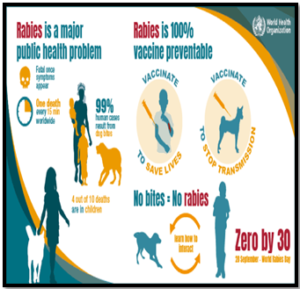DECOADING RABIES TRANSMISSION: A 16-YEAR TANZANIAM STUDY
A 16-year study in Tanzania led by Professor Katie Hampson delves into rabies transmission dynamics among dogs.
Source: WHO
About Rabies:
- Rabies is a viral disease that attacks the central nervous system, causing brain inflammation and eventually leading to death if left untreated.
- It is transmitted through the bite of an infected animal, most commonly dogs.
- Rabies is almost always fatal, but it can be prevented through vaccination.
The Study and its key findings:
- The comprehensive study spans 15 years, involving data collection on 50,000 dogs in the Serengeti district.
- Rabies persists locally, with a few “super-spreader” dogs travelling long distances, contributing to virus dissemination.
- Mass dog-vaccination, not culling, emerges as the most effective strategy against rabies spread.
- Rabies differs from typical infectious diseases as it spreads solely through bites, allowing for localized transmission.
Implications and Vaccination Advocacy:
- Traditional infectious disease models struggle to predict rabies spread due to its local nature.
- Lower dog density doesn’t necessarily reduce transmission, challenging the efficacy of culling.
- Large-scale dog vaccination is crucial for preventing rabies spread, contrasting with ineffective culling strategies.
Global Perspective and Vaccine Inequity:
- While high-income countries have successfully used vaccination to eliminate rabies, equitable vaccine distribution remains a challenge.
- In countries like India, where rabies is prevalent, mass sterilization efforts overshadow crucial vaccination initiatives.
The study advocates for prioritizing mass dog-vaccination globally to protect both canine and human populations from rabies.

 Source: WHO
Source: WHO


